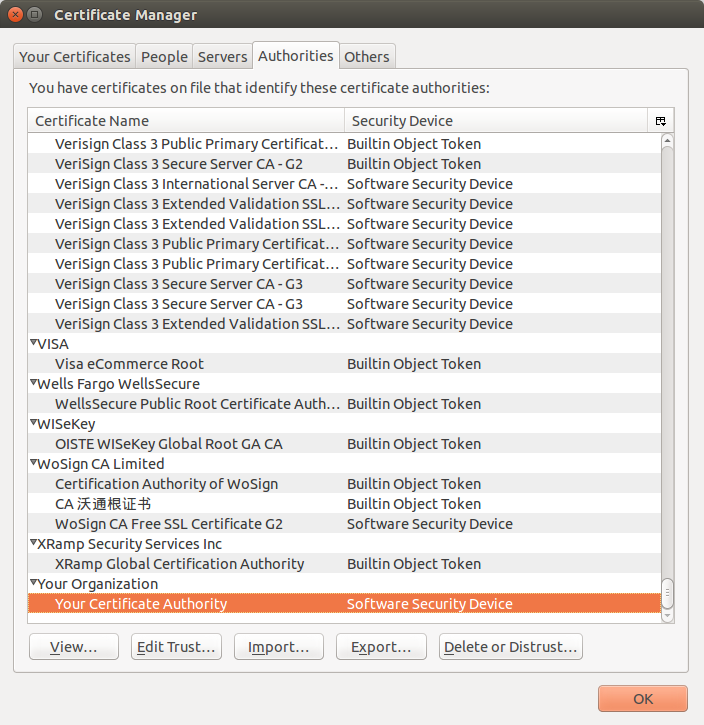Verisign Root Certificates

A root certificate is a digital certificate that belongs to the issuing Certificate Authority. It comes pre-downloaded in most browsers and is stored in what is called a “trust store.” The root certificates are closely guarded by CAs. Intermediate Certificate. Intermediate certificates branch off root certificates like branches of trees. Click Browse to navigate to VeriSign Class 3 Public Primary Certification Authority – G5.cer. Double-click this file, and then click Next. You can find this certificate in the extracted roots.zip file in the folder VeriSign Root Certificates Generation 5 (G5) PCA.
Certificate viewer allows you see other certificates in the chain by highlighting a certificate and click on the 'View Certificate' button as shown on the right below. Here the chain also shows that VeriSign is a two tier CA, where VeriSign is the Root and 'VeriSign Class 3 Extended Validation SSL SGC CA' is a Issuing CA. VeriSign Universal Root Certification Authority: VeriSign Universal Root Certification Authority: RSA: 2048 bits: SHA-256: 40 1A C4 64 21 B3 13 21 03 0E BB E4 12 1A C5 1D: 23:59:59 Dec 1, 2037: 2.16.840.1.113733.1.7.23.6: 23 99 56 11 27 A5 71 25 DE 8C EF EA 61 0D DF 2F A0 78 B5 C8 06 7F 4E 82 82 90 BF B8 60 E8 4B 3C: Visa eCommerce Root: Visa.
Self-signed ssl certificates can be used to set up temporary ssl servers. You can use it for test and development servers where security is not a big concern. Use the form below to generate a self-signed ssl certificate and key.
About SSL Certificates
SSL certificates are required in order to run web sites using the HTTPS protocol. For professional web sites, you usually buy such a certificate from Verisign, Thawte or any other ssl certificate vendor. SSL certificates use a chain of trust, where each certificate is signed (trusted) by a higher, more credible certificate. At the top of the chain of trust are the root certificates, owned by Verisign and others. These certificates are typically shipped with your operating system or web browser.

In Internet Explorer and Firefox
When you visit a web site over HTTPS, your web browser will receive the ssl certificate for the web site. It will examine the contents of the certificate to see that is indeed valid for the domain name you are trying to visit. After that, it will verify the chain of trust. It will look at who has signed the certificate. If that certificate is a root-certificate, it will compare it against the ones shipped with the operating system. If it is a non-root certificate, it will follow the chain of trust up one more level.
Self-signed certificates

When using a self-signed certificate, there is no chain of trust. The certificate has signed itself. The web browser will then issue a warning, telling you that the web site certificate cannot be verified. Therefore, you should not use self-signed certificates for professional use, as your visitors will not trust your web site to be safe.
Buying a certificate
A real certificate is safer than a self-signed. If you wish to buy a real SSL certificate, click here.
8i | 9i | 10g | 11g | 12c | 13c | 18c | 19c | 21c | Misc | PL/SQL | SQL | RAC | WebLogic | Linux
Home » Articles » Linux » Here
openssl
The openssl command line utility is a simple way to create a key and self signed certificate.
genkey (Linux)
The crypto-utils package, and therefore the genkey command have been removed from RHEL8 onward. Use openssl instead.
The genkey command allows you to generate certificate and key file pairs directly from the command line.
Verisign Root Certificate Authority
If they are not already installed, install the mod_ssl, openssl and crypto-utils packages.
The genkey command can generate a certificate request or a new self-signed certificate. The following command create a self-signed certificate for the specified machine.
The certificate and key file are created in the following locations respectively.
keytool (Java)
The keytool utility is present as part of the Java Runtime Environment (JRE), either in the standalone JRE installation, or under the 'jre' directory of the JDK installation.
The following commands creates a keystore containing a self-signed certificate.
The utility asks you to provide information in the following format.
Alternatively, you can provide the answers directly on the command line.
The following command checks the contents of the keystore.
orapki (Oracle)
The orapki utility makes handling certificates and Oracle wallets very simple.
Create a location for your wallet.
Add the location of the orapki utility to your path.
Verisign Root Certificate Download
Create a wallet to hold your certificate.
Create a self-signed certificate and add it to your wallet.
You can check the contents of the wallet with the following command.
You can read more about Oracle wallets and the orapki utility here.
Converting Between Keystores and Wallets (orapki)
Oracle Fusion Middleware can be quite confusing at times because different products handle their certificates in different ways. For example, managed servers use a JKS keystore, but the Oracle HTTP Server (OHS) requires an Oracle Wallet. Fortunately, the orapki utility allows you to convert between these two formats.
To import the contents of a JKS keystore into a existing wallet, use the following commands.
To create identity and trust keystores from a wallet, using the following command.
For more information see:
Hope this helps. Regards Tim...